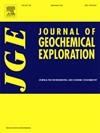刚果民主共和国Nguba集团含矿Lonshi铜矿地质及勘探意义
IF 3.4
2区 地球科学
Q1 GEOCHEMISTRY & GEOPHYSICS
引用次数: 0
摘要
龙石铜矿是一个新发现的铜矿床,位于刚果民主共和国中非铜带东南部地区。该矿床位于加丹加超级群的Nguba群中。分析了龙石矿床的岩石地层、控制构造、容矿岩及成矿特征。龙石地区的岩石地层由罗安群的姆瓦什亚砂岩组成;Nguba组的砾岩、白云岩、页岩、泥岩和粉砂岩;昆德隆古群的砾岩、粉白云岩和粉砂岩。矿区内确定的地质构造包括北南、西东向褶皱、北西向断裂、东西向左旋剪切以及各种断裂和脉体。龙石矿床具有热液层状成矿特征,由位于Mwale砾岩内的两个主矿体(下矿体)和下部龙石白云岩(上矿体)组成。矿床分3期成矿,其中第一期热液地层控制期成矿为辉铜矿1期、斑铜矿、黄铜矿和黄铁矿。构造控制的第2阶段分为第2a阶段辉铜矿和斑铜矿,第2b阶段黄铜矿、斑铜矿和原生铜。定义第3阶段的表生蚀变导致辉铜矿3、孔雀石、铜矿、蓝铜矿和原生铜矿2的沉积。与硫化铜矿物伴生的脉石矿物包括铁云母、长石、石英、白云母/绢云母、凯尔长云母、重晶石和伊利石。硫化物矿物在纵向和横向上均表现出分带性,由辉铜矿→斑铜矿→黄铜矿→黄铁矿±闪锌矿。铜硫化物矿物在Nguba砾岩中以细粒至粗粒的展布形式存在,呈替换结构。龙石矿床成矿流体可能富集Fe、Ca、Mg、Si、S和Cu,另外Mg来自赋矿白云岩,Co和K来自赋矿砾岩。龙石铜矿Nguba群具有明显的由黑色至浅灰色砾岩和白云岩组成的岩性特征,为新矿床的发现提供了有价值的认识。观察到的矿物分带、热液蚀变和多阶段矿化事件为铜的沉积提供了有利条件。在Lonshi矿附近和Nguba群寻找类似的地层环境和蚀变特征,可以增加发现新矿床的可能性,特别是在具有类似地质特征和构造特征的地区。本文章由计算机程序翻译,如有差异,请以英文原文为准。

Geology of the Nguba Group-hosted Lonshi copper deposit in the Democratic Republic of Congo and exploration implications
Lonshi is a newly discovered copper deposit located in the southeastern region of the Central African Copperbelt in the Democratic Republic of Congo. The deposit is hosted in the Nguba Group of the Katanga Supergroup. This paper analyzes the lithostratigraphy, controlling structures, ore host rock, and mineralization characteristics of the Lonshi deposit. The lithostratigraphy of the Lonshi area is comprised of the Mwashya sandstone of the Roan Group; conglomerate, dolostone, shale, mudstone, and siltstone of the Nguba Group; and conglomerate, pink dolostone, and siltstone of the Kundelungu Group. Geological structures identified within the mining zone encompass N-S and W-E trending folds, NW-trending fault, E-W sinistral shears, and various fractures and veins. The Lonshi deposit exemplifies a characteristic of hydrothermal stratiform mineralization, comprising two main orebodies situated within the Mwale conglomerate (lower orebody) and the underlying Lonshi dolostone (upper orebody). The ore was deposited during three mineralization stages, wherein the first hydrothermal stratigraphically-controlled stage deposited chalcocite 1, bornite, chalcopyrite, and pyrite. The structurally controlled stage 2 is subdivided into chalcocite 2 and bornite of stage 2a, and chalcopyrite, bornite, and native copper of stage 2b. Supergene alteration defining stage 3 resulted in the deposition of chalcocite 3, malachite, cuprite, azurite, and native copper 2. The gangue minerals associated with copper sulfide minerals consist of ankerite, feldspar, quartz, muscovite/sericite, kaersutite, barite, and illite. The sulfide minerals display zonation both vertically and laterally, transitioning from chalcocite to bornite to chalcopyrite to pyrite±sphalerite. Copper sulfide minerals occur as fine- to coarse-grained disseminations within the Nguba conglomerate andshow a replacement texture. The mineralizing fluids at the Lonshi deposit were likely enriched in Fe, Ca, Mg, Si, S, and Cu, with additional Mg contributed from the ore-hosting dolostone and Co and K from the ore-hosting conglomerate.
The Nguba Group at the Lonshi copper deposit shows distinct lithologies composed of black- to light-gray conglomerates and dolostone, which provide valuable insights for the discovery of new deposits. The observed mineral zoning, hydrothermal alteration, and multi-stage mineralizing events suggest favorable conditions for copper deposition. Targeting similar stratigraphic settings and alteration signatures in the vicinity of the Lonshi mine and in the Nguba Group could enhance the likelihood of discovering new deposits, particularly in areas exhibiting similar geological characteristics and structural features.
求助全文
通过发布文献求助,成功后即可免费获取论文全文。
去求助
来源期刊

Journal of Geochemical Exploration
地学-地球化学与地球物理
CiteScore
7.40
自引率
7.70%
发文量
148
审稿时长
8.1 months
期刊介绍:
Journal of Geochemical Exploration is mostly dedicated to publication of original studies in exploration and environmental geochemistry and related topics.
Contributions considered of prevalent interest for the journal include researches based on the application of innovative methods to:
define the genesis and the evolution of mineral deposits including transfer of elements in large-scale mineralized areas.
analyze complex systems at the boundaries between bio-geochemistry, metal transport and mineral accumulation.
evaluate effects of historical mining activities on the surface environment.
trace pollutant sources and define their fate and transport models in the near-surface and surface environments involving solid, fluid and aerial matrices.
assess and quantify natural and technogenic radioactivity in the environment.
determine geochemical anomalies and set baseline reference values using compositional data analysis, multivariate statistics and geo-spatial analysis.
assess the impacts of anthropogenic contamination on ecosystems and human health at local and regional scale to prioritize and classify risks through deterministic and stochastic approaches.
Papers dedicated to the presentation of newly developed methods in analytical geochemistry to be applied in the field or in laboratory are also within the topics of interest for the journal.
 求助内容:
求助内容: 应助结果提醒方式:
应助结果提醒方式:


